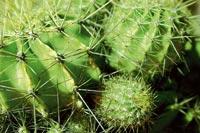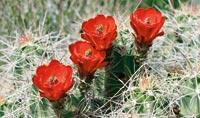Thorns and bowls to keep in the desert

Through the words that Antoine de Saint-Exúpery put in the mouth of the Little Prince, the charm of the desert is transmitted to the reader. The deserts are not dead, but they hide treasures, besides hidden water wells, there are animals and plants that give life. To survive in this harsh place, the living creatures of the desert are specially adapted. They have had to develop different strategies to deal with lack of water and temperature changes, and as each species has followed its path, there is a great variety.
Among the best adapted plants are cactus. Cactus are native to America, but other plants in the dry zone have followed a similar path. Therefore, cactus are not the only primitive spiny plants, so non-experts usually consider cactus as a family to certain plants in the form of cactus. However, they have special features, so they are exceptional.

Regarding the rest of plant families, cactus are relatively new. Being originally only in America, it seems that this continent originated after its separation from Africa. Analyzing the fossils, it is believed that they first appeared in South America and then expanded across the continent. Except in very northern latitudes, they have occupied most habitats, from the rain jungle to the mountain. Yes, the vast majority are in the deserts.
The Cactaceae family comprises approximately 130 genera and 1,500 species. There seems to be a lot of difference between some species and others, but they are all relatives and therefore have a familiar tone. Its main feature is its storage capacity.
Living deposits of water
When cutting any cactus is seen inside a whitish liquid. 90% is water. Tell us: A giant Carnegia can reach three thousand liters. In an area that barely rains, a plant of this type is like an oasis. For this reason, cactus have mechanisms to protect themselves from thirsty animals. Some are surrounded by thorns; others have turned the liquid into poisonous, and there are those who have most of them underground.

The cactus metabolism is prepared to save water. In the winter time they hardly need water and the walls of the cells contract or increase depending on the water they contain. The water transport system in the interior of the plant is relatively low and is mainly carried out by osmosis. The surface of the cactus presents an osmotic pressure superior to that of the interior, which facilitates the entry of water.
In addition to water there are non-freeze substances in the cactus liquid. It must be taken into account that in the desert the temperature can be zero at night. Proteins have also been found to help withstand high temperatures in the liquid of some species.

On the other hand, to avoid evaporation of water, the cactus are covered by a waxed cuticle. To that is due its brightness. The form is also adequate to lose as little water as possible, and many are prism-shaped or formed by ovoid parts. In this way, some parts remain in the shade of others and the Sun does not fully reach the entire plant. In addition, the interstitials act as channels that lead to the interior of the dew that accumulates on the surface. In spiny cactus, thorns also help to collect and assimilate water and other thorns give shade.
Another way to avoid evaporation is the loss of leaves. Some cactus hardly have leaves and many have completely disappeared. Most plants perform photosynthesis in the leaves, while the cactus do it in the stems. That is why they are green, because they have chlorophyll there.
Photosynthesis on two occasions
Photosynthesis allows plants to generate organic compounds and oxygen from the water and carbon dioxide of the air. The exchange of gases occurs in the orifices called stomata, but also transpiration. Perspiration, of course, is counterproductive in dry places. Therefore, to avoid the loss of water, the cactus have few stomata and only open at night. However, at night there is no Sun and its energy is essential to realize photosynthesis...

But the Kaktus find an effective trick: Photosynthesis KAM. The acronym KAM indicates the acid metabolism of crasulaceans, which was the first family to be studied. The first studies date from 1804, when some cactus of the genus Opuntia showed that they absorbed carbon dioxide at night. Later, they saw that the leaves of Bryophillum calcinum were very acidic in the morning, but enjoyed as the day progressed.
They continued to investigate and found that photosynthesis occurs twice in some plants: at night, plants absorb carbon dioxide and release oxygen. Carbon dioxide, through a chain of reaction, becomes part of the malic acid and is stored. During the day, taking advantage of the energy of the Sun, the malic acid is decomposed and the necessary glycids are generated to feed the plants.
By using enough energy to accumulate and decompose malic acid, cactus grow slowly.
Thorny protection

This special photosynthesis is also done by several plants that are not cactus. The thorns and areoles are, however, the true signs of identity of the family Cactaceae. Other plants also have thorns, but they are not like cactus. In fact, others are superficial, but in the cactus they reach the bottom and are connected with inner tissues. Therefore, botanists believe that they also serve to internalize water or food.
The thorns grow in the areoles. The Arenas are special organs of the cactus. They are equivalent to the eyes of other plants and, like these, leaves, buds or flowers form from the areoles. In addition, from another place of the areola are also extracted hairs, crines, blood cells or thorns. In some cactus, the structures of both types stand out in the same areola, while in others the structures are provided by separate areoles.

In general, the central thorns of the areola serve to protect themselves from predators, while those around the foot of the spine provide shade. In some cactus have hair shape, and the extreme example is Cephalocereus senilis: long white hairs cover the entire plant and protect it completely from the Sun.
Another variant of the mouldings are the blood cells. They are from the family of the Indipedo and are an eaglet bent backwards. They are very easy to put on the skin and can hardly leave, so predators learn quickly that it is better not to approach these cactus.
Color Color Color Color

There are no roses without thorns, something similar can be said of cactus. All cactus have flowers. However, these flowers last a few days not to lose water and, in addition, they are usually surrounded by thorns to protect themselves from those who want to eat.
However, they need help from animals to pollinate. Therefore, in addition to attractive colors and aroma, they usually have many nectars and pollen. Some cactus are specialized and only some specific insects or bats can catch their nectar. In addition, these animals only open during the search for food, usually at night. Other cactus, on the contrary, accept the help of anyone and do not pose difficulties to take nectar and pollen.

When the seeds begin to form, the fruits grow. Some species produce nuts. These do not usually have a special color, and when arriving they open without more. The fruits of many others are fleshy and colorful, yellow, red or orange. They often do not have thorns so that animals can eat easily. The objective is that the animals eat their fruits and then the seeds are extended with the feces.
As with other cactus structures, the roots are adapted to the environment. In most cases, they have long roots, close to the surface, occupying a large area. As it rains, they are filled with water and transport the liquid to the plant. However, some species retain water in their own roots, so they usually have thick roots.
Fascinating fascinating fascinating fascinating is the
The cactus are, therefore, singular plants and it is no wonder their use as ornamentation. But it is not the only use of cactus. It is clear that they have been used to quench thirst in the desert, although often the liquid has an acid flavor. But the fruits of some are really sweet, like that of the Hindus, and they are planted as fruit trees.

In addition, the use of the Indian is another: it is the host of the cochinilla. Cochinilla is a bug that attacks the plant and the females are used to make a red coloring. In this way, the Indian is intentionally infected with the cochineal, to later collect, dry, crush and use the females as dyes. With this, the fabrics are dyed and cosmetics, watercolors and paints are made.
In addition, various varieties without thorns are used to feed animals. Other cactus, on the other hand, have large wooden stems, so they are used in carpentry. For this purpose, those of the genus Trichocereus are especially appropriate. On the other hand, the thorns of several cactus have been used to manufacture needles and combs.
These uses are being lost over time. Others do not seem to miss easily. For example, in Mexico and the southeast of the US. There is a cactus, the peyte, of hypnotic action. From there comes the mescaline and has always been used in medicine and religious ceremonies. Although today they consider it a drug, it is still taken.

In addition to the pawn, many other cactus also contain psychoactive substances. In fact, pharmaceutical industries are very interested in these compounds, as they can be suitable for their medical use. They seem to be as special from inside as from outside.
For all this, they are very appreciated and although they grow well in vegetable nurseries, some take them from their places of origin. The market is so large that there are threatened species. In Mexico alone, 257 species are endangered, 24 of them in danger of extinction. As often happens, beauty has an expensive cost.
Buletina
Bidali zure helbide elektronikoa eta jaso asteroko buletina zure sarrera-ontzian











